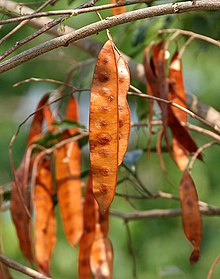Albiziais agenusof more than 160speciesof mostly fast-growingsubtropicalandtropicaltreesandshrubsin the subfamilyMimosoideaeof thefamilyFabaceae. The genus ispantropical,occurring in Asia, Africa, Madagascar, America and Australia, but mostly in theOld Worldtropics. In some locations, some species are consideredweeds.
| Albizia | |
|---|---|

| |
| Persian silk tree (Albizia julibrissin), foliage and blossoms | |
| Scientific classification | |
| Kingdom: | Plantae |
| Clade: | Tracheophytes |
| Clade: | Angiosperms |
| Clade: | Eudicots |
| Clade: | Rosids |
| Order: | Fabales |
| Family: | Fabaceae |
| Subfamily: | Caesalpinioideae |
| Clade: | Mimosoid clade |
| Genus: | Albizia Durazz.(1772) |
| Diversity | |
| About 150 species | |
| Synonyms[1] | |
| |

They are commonly calledsilk plants,silk trees,orsirises.The obsolete spelling of the generic name – with double 'z' – is still common, so the plants may be calledalbizzias.The generic name honors the Italian noblemanFilippo degli Albizzi,who introducedAlbizia julibrissinto Europe in the mid-18th century.[2]Some species are commonly calledmimosa,which more accurately refers to plants of genusMimosa.Species from southeast Asia used for timber are sometime termedEast Indian walnut.
Description
editThey are usually small trees or shrubs with a short lifespan, though the famousSamán del GuèrenearMaracayinVenezuelais a hugeAlbizia samanspecimen several hundred years old. Theleavesarepinnatelyor bipinnately compound. The smallflowersare in bundles, withstamensmuch longer than thepetals.The stamens are usually showy, although in some species such asA. canescensthe flowers are inconspicuous.[3]
Unlike those ofMimosa,Albiziaflowers have many more than 10 stamens.Albiziacan also be told apart from another large related genus,Acacia,by its stamens, which are joined at the bases instead of separate.[4]
Taxonomy
editNumerous species placed inAlbiziaby early authors were eventually moved to other genera, most notablyArchidendron.Other genera ofIngeae(Abarema,Archidendropsis,Blanchetiodendron,Calliandra,Cathormion,Enterolobium,Havardia,Hesperalbizia,Hydrochorea,Pararchidendron,Paraserianthes,PseudosamaneaandSerianthes) have also received their share of formerAlbiziaspecies, as have theMimoseaeNewtoniaandSchleinitzia.Some presumed "silk trees" are in fact misidentified members of the not very closely related genusErythrophleumfrom theCaesalpinioideaeandLebeckiafrom theFaboideae.[5]
The delimitation ofFalcatariaandPithecellobium,close relatives ofAlbizia,is notoriously complex, with species having been moved between the genera time and again, and this will likely continue. These includeFalcataria falcata(the Moluccan albizia, formerly namedAlbizia moluccana), a common shade tree onteaplantations. Other closely related genera likeChloroleuconandSamaneaare often merged withAlbiziaentirely.[5]
Uses
editAlbizias are importantforage,timber,andmedicinal plants,[6][7]and many are cultivated asornamentalsfor their attractive flowers – notablyAlbizia julibrissin.[8]
Some species are used as food plants by thelarvaeofmothsin the genusEndoclita,includingE. damor,E. malabaricus,andE. sericeus.
See also
editReferences
edit- ^AlbiziaDurazz.Plants of the World Online.Retrieved 4 August 2023.
- ^Albizia adianthifoliaCredit to South African National Biodiversity Institute.
- ^Lowry, J.B. 2008.Trees for Wood and Animal Production in Northern Australia.Rural Industries Research and Development Corporation. Indooroopilly, Queensland.
- ^Singh, Gurcharan (2004).Plant Systematics: An Integrated Approach.Science Publishers. p. 445.ISBN1-57808-351-6.
- ^abILDIS (2005)
- ^Lowry, J.B.; Prinsen, J.H. & Burrows, D.M. (1994): 2.5 Albizia lebbeck – a Promising Forage Tree for Semiarid Regions.In:Gutteridge, Ross C. & Shelton, H. Max (eds.):Forage Tree Legumes in Tropical Agriculture.CAB Intemational.HTML fulltextArchived2007-04-05 at theWayback Machine
- ^Joycharat N, Thammavong S, Limsuwan S, Homlaead S, Voravuthikunchai SP, Yingyongnarongkul BE, Dej-Adisai S, Subhadhirasakul S (2013). "Antibacterial substances from Albizia myriophylla wood against cariogenic Streptococcus mutans".Archives of Pharmacal Research.36(6): 723–730.doi:10.1007/s12272-013-0085-7.PMID23479194.S2CID11823016.
- ^"Albizia julibrissin".RHS.Retrieved27 February2020.
External links
edit- Dressler, S.; Schmidt, M. & Zizka, G. (2014)."Albizia".African plants – a Photo Guide.Frankfurt/Main: Forschungsinstitut Senckenberg.